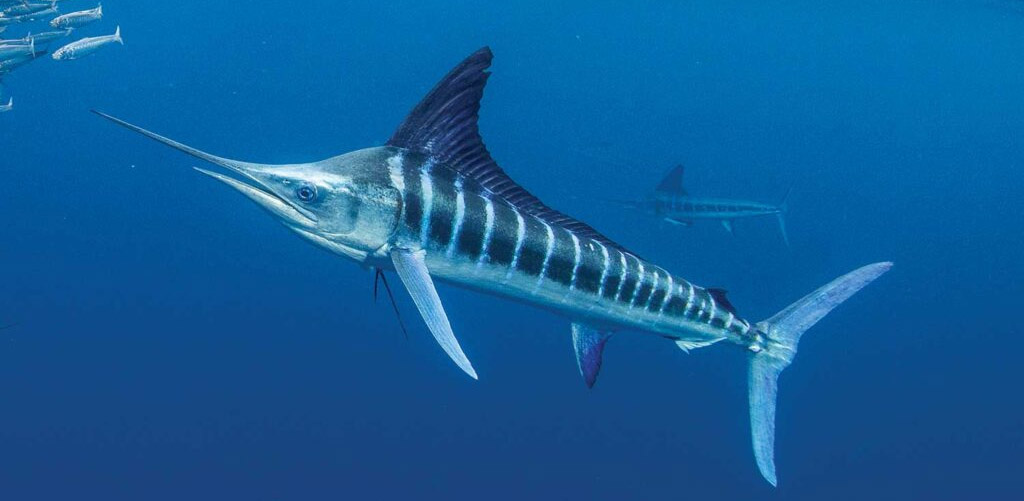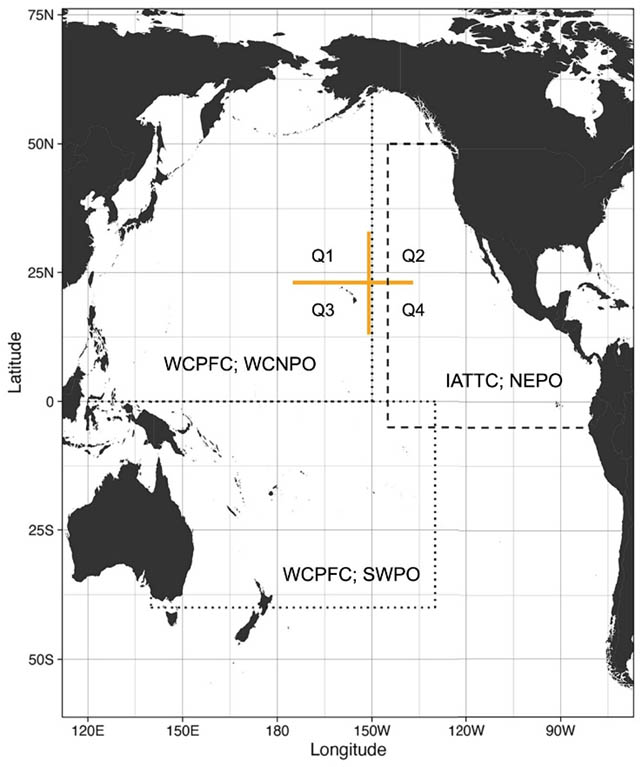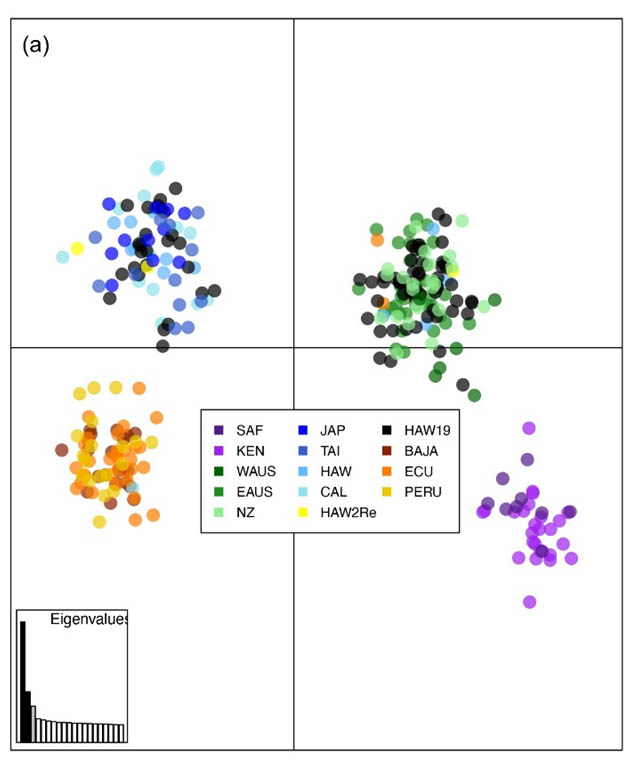New Genetic Research on Striped Marlin Reveals Extensive Stock Mixing in the Central North Pacific

In September 2025, IGFA Conservation Programs Manager, Jackson Martinez, in collaboration with Dr. Jan McDowell and Dr. John Graves of the Virginia Institute of Marine Science, published a landmark study examining the genetic stock composition of striped marlin in the central North Pacific Ocean (CNP). Martinez first presented the research at the 7th International Billfish Symposium in October 2024, and the full paper will appear in a Special Symposium Issue of the ICES Journal of Marine Science in early 2026.
Accurately identifying population structure or “stocks" is fundamental to the effective management and conservation of billfish, tunas, and other large pelagic fishes. These species are highly migratory, traversing entire ocean basins and undergoing passive larval dispersal that can diminish genetic differentiation among sub-populations. Although the open ocean environment can facilitate high levels of gene flow, some of these species have been found to exhibit low levels of genetic structuring among and in some cases, within ocean basins, making it difficult for fishery managers to align management boundaries with biological sub-populations.
For striped marlin, prior research has suggested three to four genetic stocks in the Pacific and one to two in the Indian Ocean. While most studies agree on the existence of at least one genetically distinct North Pacific stock, some have hinted at the possibility of another unique stock within the CNP—a region heavily utilized by the Hawaii-based pelagic longline fishery. Martinez and his co-authors set out to clarify the number of stocks present in the region and to characterize, on a month-to-month basis, how these stocks mix within the fishery.

Jackson Martinez is the IGFA’s Conservation Programs Manager. A Houston native and lifelong angler, he previously worked at Environmental Defense Fund, advancing science-based policy for sustainable federal fisheries. Jackson specializes in stakeholder engagement and fisheries conservation, and he brings experience in both science and policy to support the IGFA’s mission. He holds an M.S. in Marine Science from VIMS, where he studied striped marlin stock structure, and dual B.S. degrees in Marine Biology and Marine Fisheries from Texas A&M–Galveston.
Genetics Uncover Striped Marlin Pathways
For billfish, tunas, and other large pelagic fishes, the accurate identification of populations, or stocks, is fundamental to the development of effective management and conservation measures. The highly migratory nature of these species, combined with the potential for passive larval dispersal, may result in the slow accumulation of genetic differences among populations of a given species. In other words, high gene flow in the open ocean may slow the development of genetically distinct stocks.
For striped marlin, previous studies have identified three to four genetic stocks in the Pacific Ocean and one to two stocks in the Indian Ocean. Although these studies have all recognized at least one distinct genetic stock distributed across the North Pacific (e.g., Japan, Taiwan, Hawaii, and California sampling locations), two previous studies suggested the possibility of a second unique stock occurring in the CNP. The goals of this study were to 1) clarify the number of stocks occurring within the CNP and 2) use temporal monthly sampling to characterize the stock dynamics of striped marlin exploited by the Hawaii-based pelagic longline fishery.
To address these questions, the authors enlisted the help of fishery observers from the NOAA Fisheries Pacific Islands Regional Office to collect striped marlin samples while operating on vessels in the Hawaii longline fishery. From September 2019 to October 2020, over 400 striped marlin fin clips were collected from the waters off Hawaii and the broader CNP. Each fin clip came with associated biological information, including fish size, sex, sampling location, time of year, and an estimate of spawning condition at the time of capture.

A subset of the samples collected from the Hawaii longline fishery underwent next-generation sequencing, and the genetic data were added to an existing dataset from a previous study that investigated striped marlin stocks throughout their full range. Analyses of the combined dataset identified the presence of a single North Pacific stock (NPO) of striped marlin. Interestingly, the study revealed that many of the striped marlin sampled off Hawaii belonged to an Oceania stock, comprising sample collections from western Australia, eastern Australia, and New Zealand (see HAW19 in figure 2 below).

Once the stock structure in the CNP was clarified, the authors utilized advanced genotyping and genetic assignment methods to analyze and assign the rest of the sample collection to their stock of origin. Thanks to the extended sampling efforts of fishery observers in the Hawaii longline fleet, a major finding of this study was the characterization of the changes in the stock composition of the fishery over time. Over the 14-month sampling period, 41% of striped marlin were assigned to the NPO stock and 59% assigned to Oceania, with the proportion of the NPO stock increasing from the late fall to the early summer months (November-June), and the proportion of Oceania striped marlin increasing starting in the summer and peaking in the fall months (July-October).

The authors identified the CNP as a crucial mixing ground for multiple stocks of mostly juvenile striped marlin and found that stock mixing occurred across different management boundaries and Regional Fisheries Management Organization (RFMO) jurisdictions, suggesting joint management efforts by Pacific RFMOs to improve the conservation status of this trans-boundary species.
Given that the management stock boundaries established by RFMOs often do not align with the best available biological data, this study is highly relevant to improving striped marlin management and conservation efforts. Striped marlin are currently experiencing various degrees of overexploitation via targeted and incidental fisheries catch throughout their range, and are considered likely overfished and likely undergoing overfishing in the western and central North Pacific and southwestern Pacific management stocks, with the western and central North Pacific stock currently under a formal rebuilding plan.
While this study provides one of the most comprehensive investigations into the mixing patterns and stock dynamics of CNP striped marlin to date, it is clear that we still have much to learn about striped marlin movement and biology. In addition to molecular genetic methods, satellite tags are a useful tool for understanding the movements and habitat utilization of these highly migratory species. Recent tagging data from the IGFA Great Marlin Race is beginning to provide insight into long-distance movements of striped marlin, with one tagged fish traveling from New Zealand toward the northeast to south of the equator in the central Pacific and another that traveled from New Zealand to just off the Galapagos Islands.
